Resumen
Seafood contains high-quality protein, vitamins, and minerals that have many health benefits, but the average family’s consumption of seafood in the United States remains below recommended levels. To begin to understand how to raise consumption levels, the study described in this 3-page fact sheet focuses on the influence parents’ seafood consumption habits may have on their children. Written by Anh Sam, Xiang Bi, and Lisa House, and published by the Department of Food and Resource Economics, July 2016.
Citas
Bi, X., House, H., & Gao, Z. (2016). "Impacts of nutrition information on choices of fresh seafood among parents." Marine Resource Economics. http://dx.doi.org/10.1086/686714 https://doi.org/10.1086/686714
Florida Sea Grant. (2016). https://www.flseagrant.org/publications/seafood/
Kluger, J. (2010, August 25). "Salmon baby good: How to get children to eat fish." Time. http://www.time.com/time/health/article/0,8599,2013098,00.html.
Seafood Health Facts. (2015). A joint project of Oregon State University, Seafood Consumer Center, Cornell University, and the Universities of California, Delaware, Florida, and Rhode Island. http://www.seafoodhealthfacts.org/
US HHS. (2015). Dietary guidelines for Americans. Washington, DC: Department of Health and Human Services.
Wysocki, A.F., House, L., & Messina Jr, W.A.. (2009). Seafood Perception Among People Aged 55 and Above: Summary of Focus Groups Results. FE821. Gainesville: University of Florida Institute of Food and Agricultural Sciences. https://edis.ifas.ufl.edu/FE821

